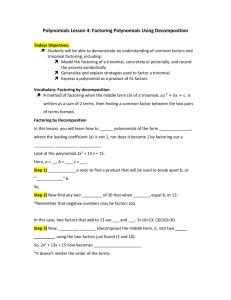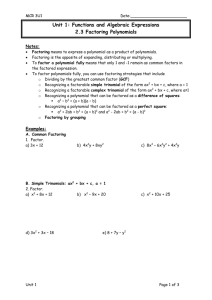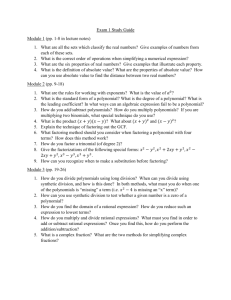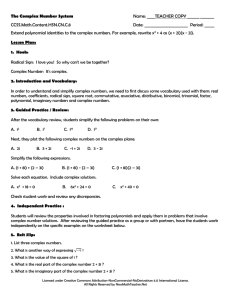algebra ideas for chapter five, section eleven
advertisement
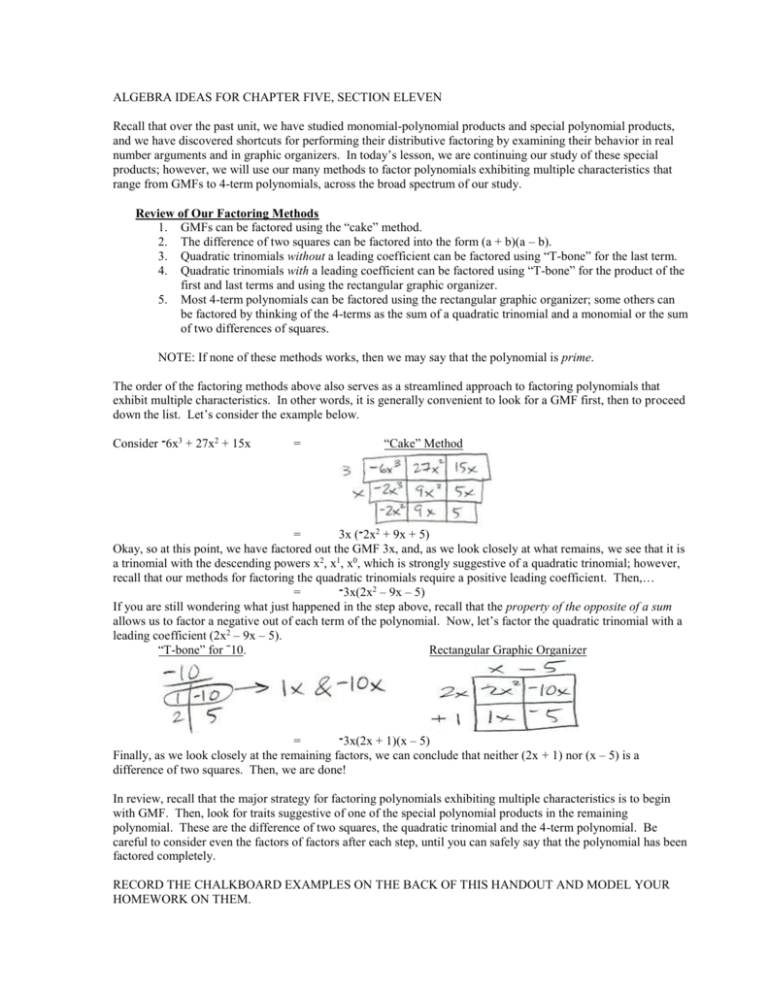
ALGEBRA IDEAS FOR CHAPTER FIVE, SECTION ELEVEN Recall that over the past unit, we have studied monomial-polynomial products and special polynomial products, and we have discovered shortcuts for performing their distributive factoring by examining their behavior in real number arguments and in graphic organizers. In today’s lesson, we are continuing our study of these special products; however, we will use our many methods to factor polynomials exhibiting multiple characteristics that range from GMFs to 4-term polynomials, across the broad spectrum of our study. Review of Our Factoring Methods 1. GMFs can be factored using the “cake” method. 2. The difference of two squares can be factored into the form (a + b)(a – b). 3. Quadratic trinomials without a leading coefficient can be factored using “T-bone” for the last term. 4. Quadratic trinomials with a leading coefficient can be factored using “T-bone” for the product of the first and last terms and using the rectangular graphic organizer. 5. Most 4-term polynomials can be factored using the rectangular graphic organizer; some others can be factored by thinking of the 4-terms as the sum of a quadratic trinomial and a monomial or the sum of two differences of squares. NOTE: If none of these methods works, then we may say that the polynomial is prime. The order of the factoring methods above also serves as a streamlined approach to factoring polynomials that exhibit multiple characteristics. In other words, it is generally convenient to look for a GMF first, then to proceed down the list. Let’s consider the example below. Consider ־6x3 + 27x2 + 15x = “Cake” Method = 3x (־2x2 + 9x + 5) Okay, so at this point, we have factored out the GMF 3x, and, as we look closely at what remains, we see that it is a trinomial with the descending powers x2, x1, x0, which is strongly suggestive of a quadratic trinomial; however, recall that our methods for factoring the quadratic trinomials require a positive leading coefficient. Then,… = ־3x(2x2 – 9x – 5) If you are still wondering what just happened in the step above, recall that the property of the opposite of a sum allows us to factor a negative out of each term of the polynomial. Now, let’s factor the quadratic trinomial with a leading coefficient (2x2 – 9x – 5). “T-bone” for ˉ10. Rectangular Graphic Organizer = ־3x(2x + 1)(x – 5) Finally, as we look closely at the remaining factors, we can conclude that neither (2x + 1) nor (x – 5) is a difference of two squares. Then, we are done! In review, recall that the major strategy for factoring polynomials exhibiting multiple characteristics is to begin with GMF. Then, look for traits suggestive of one of the special polynomial products in the remaining polynomial. These are the difference of two squares, the quadratic trinomial and the 4-term polynomial. Be careful to consider even the factors of factors after each step, until you can safely say that the polynomial has been factored completely. RECORD THE CHALKBOARD EXAMPLES ON THE BACK OF THIS HANDOUT AND MODEL YOUR HOMEWORK ON THEM.




